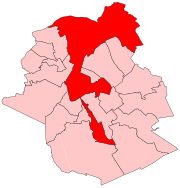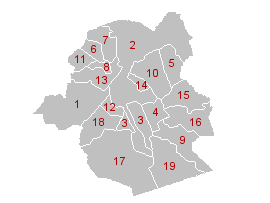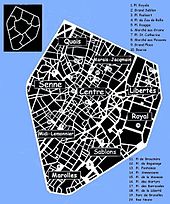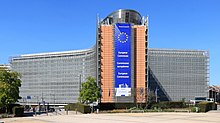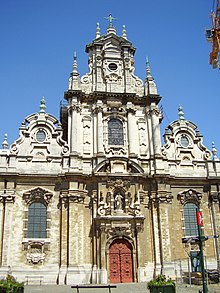City of Brussels
| City of Brussels | ||
|---|---|---|

|

|
|
|
|
||
| State : |
|
|
| Region : | Brussels capital | |
| Province : | ("de-provincialized" since January 1st, 1995) | |
| District : | Brussels capital | |
| Coordinates : | 50 ° 51 ′ N , 4 ° 21 ′ E | |
| Area : | 32.61 km² | |
| Residents: | 181,726 (Jan 1, 2019) | |
| Population density: | 5,573 inhabitants per km² | |
| Height: | 70 m | |
| Post Code: | 1000 (Brussels) 1020 (Laken) 1120 (Neder-Over-Heembeek) 1130 (Haren) |
|
| Prefix: | 02 | |
| Mayor: | Philippe Close ( PS ) | |
Local government address : |
Center Administratif Boulevard Anspach 6 1000 Bruxelles Administratief Centrum Anspachlaan 6 1000 Brussel |
|
| Website: |
www.bruxelles.be www.brussel.be |
|
The city of Brussels (mostly only Brussels ; French Ville de Bruxelles [ bryˈsɛl ], Dutch Stad Brussel [ ˈbrɵsəɫ ]) is one of the 19 municipalities of the Brussels-Capital Region and the capital of the Kingdom of Belgium with 181,726 inhabitants (January 1, 2019) in the official Municipal area. The settlement area of the Brussels-Capital Region, however, has 1.2 million inhabitants. Since the municipality also includes some parks, the population density of the municipality with 5,414 inhabitants per km² is lower than that of the capital region with 7,298 inhabitants per km².
Seat of various institutions
Brussels-City is the capital and residence of the Kingdom of Belgium , seat of the institutions of the Flemish and French Communities of Belgium and Flanders and the capital of the Brussels-Capital Region. In addition, the city is the headquarters of the European Union and the headquarters of NATO , as well as that of the permanent secretariat of the Benelux countries, EUROCONTROL and the former Western European Union .
history
Brussels was granted city rights in 1229, after which the first 4 km long wall ring was built, which essentially enclosed the craftsmen's settlement around the Great Market. On the hillside east of this settlement, the Koudenberg Palace , the seat of the dukes and later the governor, was built in several construction phases , although it burned down due to an accident in the night of February 3rd to 4th, 1730. As early as the late 14th century, the city had grown so much that a second wall ring was built, of which the Hallepoort (Hallesches Tor) has been preserved and whose course is now marked by the wide boulevards of the Kleine Ring .
The town hall was built between 1401 and 1421. In 1426 the craft guilds gained significant influence in the city administration. Magnificent guild and guild houses lined up around the Great Market. As early as 1522, the Habsburg regent Margaret of Austria had the first Protestant believers arrested. On July 1, 1523, the Augustinian monks Johannes van Esschen and Hendrik Vos , the first Lutheran Protestants , were publicly burned on the market square after a judgment by the Inquisition .
After the bombing of Brussels by French troops in August 1695, only the town hall was rebuilt in the Gothic style, the guild houses were rebuilt in the Baroque style. This gave the Grand-Place its present form.
As part of the expansion of the city of Brussels to become the Belgian capital, the Avenue Louise was incorporated into the city of Brussels with the Bois de la Cambre. In 1855 the city received a new district, the Quartier Léopold with today's Europaviertel , whereby the municipality of Saint-Josse lost 142 of its former 253 hectares.
In 1921 the original city of Brussels merged with the sub-municipalities of Laken, Neder-Over-Heembeek and Haren.
As mayor, the socialist Freddy Thielemans shaped city politics for a long time from 1994 to 1995 and especially from 2001 to 2013. After his resignation in December 2013, one year after his re-election, he was succeeded by the socialist Yvan Mayeur . He resigned on June 8, 2017 on the occasion of the Samusocial scandal (misappropriation of public funds) and the socialist Philippe Close became his successor.
The Brussels (-city) commune in the Brussels-Capital Region
The city of Brussels (the red area on the map) originally only consisted of the city center of Brussels, which is called Brussels Center or, because of its pentagonal shape, also called the Pentagon . Today the city of Brussels can be divided into six districts (see next section).
The community has 181,726 inhabitants (as of January 1, 2019) and is 32.61 km² in size.
In the north, the city borders on the province of Flemish Brabant . Otherwise Brussels City ( 2 ) borders on:
7 Jette
13 Molenbeek-Saint-Jean / Sint-Jans-Molenbeek
1 Anderlecht
12 Saint-Gilles / Sint-Gillis
17 Uccle / Ukkel
19 Watermael-Boitsfort / Watermaal-Bosvoorde
4 Etterbeek
10 Schaerbeek / Schaarbeek
14 Saint-Josse-ten-Noode / Sint-Joost-ten-Node
5 Evere
3 Ixelles / Elsene (divided into two parts)
The municipalities of Ganshoren (6), Sint-Agatha-Berchem (11), Koekelberg (8), Vorst (18), Oudergem (9), Sint-Pieters-Woluwe (16) and Sint-Lambrechts-Woluwe (15) have none common border with the city of Brussels .
Districts
The six districts of the city of Brussels are the Pentagon (city center), Laken, Neder-over-Heembeek, Haren, the Europaviertel ( Quartier Léopold UE ) and the southern axis Louise / Louiza-Roosevelt.
Center (Pentagon / Vijfhoek)

The center ( Pentagon / Vijfhoek ) is divided into several districts ( quartiers , "Quartiere"):
- Ilot Sacre: the holy island is the core of the city, u. a. with the big market and the stock exchange
- Sainte-Catherine / Sint-Katelijne: central objects are the churches of Sainte Catherine and Saint Jean-Baptiste du Béguinage
- Saint-Gery-Dansaert / Sint-Gorik-Dansaert: the center is the old Halles Saint-Gery market hall
- Midi-Lemonnier / Lemonnier-Zuid: the most striking building is the Palais du Midi
- Marolles / Marolles: the Palace of Justice is unmistakable here
- Sablon / Zavel: the church Notre-Dame du Sablon is located here
- Saint-Jacques / Sint-Jacob: the Manneken Pis is famous
- Royale / Koning: shaped by the cathedral , the Royal Palace , the Place Royale, the Palace of the Nation and the adjacent Parc de Bruxelles ( Warandepark )
- Marais-Jacqmain / Jacqmain-Broek: with the Place de Brouckere and the Théâtre Royal de la Monnaie
- Libertes / Vrijheid: with the Place du Congres and the congress column
- Les Quais / Kaaizone: quai aux Briques, maison de La Bellone, Thurn und Taxis, Kaaitheater, Ric's Art Boat and Ric's River Boat .
Laeken / Laken
Laeken is located in the north-west of the city of Brussels and until its incorporation in March 1921 was an independent municipality that has retained its own postcode 1020 to this day. In 2005 there were 51,839 inhabitants. In Laeken you can find the Atomium , the King Baudouin Stadium , the Heyselpark , the exhibition center and the royal castle .
Neder-Over-Heembeek
This district is located in the northwest and kept its own postcode 1120 even after the incorporation. Originally it consisted of two villages on the creek Heembeek ("Hausbach"), which were known as Over-Heembeek ("Ober-Heembeek") and Neder-Heembeek ("Unter-Heembeek") since 1284 and merged in 1814. The first mention was made in a document 673, when the Merovingian king Theuderich III. Haimbecha transfers to the monastery of Saint-Vaast-Lez-Arras, which owned a lordship in Hainaut . This makes Neder-Over-Heembeek the oldest municipality in the Brussels Capital Region.
In 2005 Neder-Over-Heembeek had 13,313 inhabitants. In the district is the Queen Astrid Military Hospital (MHKA; French: Hôpital militaire Reine Astrid ; Dutch: Militair Hospitaal Koningin Astrid ) of the Belgian armed forces , which was built in 1974 .
To the northeast of Neder-Heembeek was the hamlet of Ransbeek , which fell victim to the construction of a large coking plant , the Cokeries de Marly , in the 1930s . Only the baroque Lendrik Chapel, consecrated in 1669, could be saved and was rebuilt a few hundred meters further north in the area of the Drie Fonteinen park domain in Vilvoorde . The chapel stood above a small spring, which is still surrounded by a small wood. The Hof van Crayenhove was located in Ransbeek and was replaced by Moriensart Castle in the 17th century.
The Battle of Ransbeek took place in Ransbeek in 1142 or 1147 , as part of the Grimbergen War between 1139/1141 and 1159. Walter van Mechelen and Geeraard van Grimbergen from the house of the Lords of Berthout , County Leuven, declared war after the Duke Gottfried II. , Duke of Brabant and Count of Leuven had died and his successor Gottfried III. should have been only two years old. According to legend, he hung next to the battlefield in a cradle in an oak tree and peed against the oak several times during the three-day battle. After the victory of the Duchy of Brabant, the oak tree was brought to Brussels to commemorate it and placed there in the rue du Chêne / Eikstraat , together with a bronze figure of the peeing duke as Manneken Pis
Haren
The relatively isolated district of Haren lies east of the Senne between the municipalities of Evere , Diegem and Machelen and is surrounded by numerous railway lines. After its incorporation in 1921, it kept its own postal code 1130. Haren was first mentioned in 1040, the name is derived from the pre-German word Aar, which means "fast-flowing water" and has derivatives of Ahr, Aarau, Aren. The old Brabant form Haeren is preserved today in the French spelling, while the Dutch-language official version is today Haren and is also becoming increasingly popular in French-language use.
The old village of Haeren lies east of the Senne between the two hills Harenberg and Dobbelenberg, which are still easily recognizable today. Several streams flowed through it, u. a. from the Beemdgracht and the Hollebeek, both of which flowed into the Senne at the level of the Buda Bridge. In 1322 the only partially preserved castle was first mentioned as Castrum apud Haren .
Haren is the headquarters of NATO and Eurocontrol . The first Belgian airport was also located on the territory of Haren (and partly of Evere), which was opened in 1914 as part of the German occupation in World War I and was used as a civil and military airport until 1949 when the airport in Zaventem / Melsbroek was rebuilt. The former Belgian airline Sabena was also based in Haren.
In 2005 there were 4,062 inhabitants.
Europaviertel
Important buildings in the EU quarter are the Berlaymont building , in which the European Commission has its headquarters, the Justus Lipsius building , the seat of the Council of the European Union and the European Parliament . The statue of Europe named Unity in Peace is a sculpture in Brussels' EU quarter. Many embassies and interest groups are also based in this district.
politics
Long-time mayor was Freddy Thielemans from the Socialist Party (PS) from 2001 to 2013 . In the local elections on October 14, 2012, the socialists (as a joint list of PS and sp.a ) won 29.1% of the vote, the liberals ( Mouvement Réformateur (MR) and Open-VLD ) 17.9% and formed a new one Coalition that comprised 25 of the 41 votes of the Francophone City Council members and 4 of the eight Flemish members. At the end of 2013, Thielemans resigned for reasons of age, followed by Yvan Mayeur , also from the Socialist Party and previously chairman of the CPAS ( Center Public d'Action Sociale , roughly the social welfare office). Mayeur resigned from his post in June 2017 after allegations had been raised that he had received excessive attendance fees at the homeless organization Samusocial . On July 20, 2017, the previous chairman of the PS group in the Brussels regional parliament, Philippe Close , was sworn in as his successor.
As in previous years, the budget for 2017 is balanced and comprises 770 million euros, plus an investment budget of 120 million euros, half of which is contributed by the region, the country and Europe. Of the budget, 8% is accounted for by debt servicing, and about half for the more than 8,000 employees. Due to the distribution of tasks at the municipal, regional, community and federal level, the largest share of the budget goes to schools (28.4%), followed by district development projects ( Contrats de Quartier / Wijkcontracten , 9.3%) and local public transport ( 9.2%).
Attractions


The following list shows a selection of sights in the city of Brussels. (For sights of the Laken district, see Laken ; for sights of the Brussels-Capital Region, see Brussels ).
Sacred buildings
- Cathedral of St. Michael and St. Gudula ( → location )
- Notre-Dame de la Chapelle ( → Location )
- Notre-Dame du Sablon ( → Location )
- Saint Jean-Baptiste du Béguinage ( → Location )
- Sainte Catherine ( → Location )
- Saint Nicolas ( → location )
- Notre Dame du Bon Secour ( → Location )
- Notre Dame aux Riches Claires ( → Location )
- Saint Jacques de Coudenberg ( → Location )
- Notre Dame du Finistère ( → Location )
- Chapelle de la Madeleine ( → Location )
Secular buildings
- the town hall, the Maison du Roi and the guild houses on the Grand-Place ( → location )
- Royal Palace ( → Location )
- the triumphal arch and the museums in the Jubelpark
- La Monnaie (Théâtre Royal de la Monnaie / Muntschouwburg) ( → Location )
- the Royal Flemish Theater Brussels ( → Location )
- the palace of justice ( → location )
- the Palace of the Nation , seat of the Belgian federal parliament ( → location )
- the stock exchange ( → location )
- the Berlaymont building , central building of the European Union ( → location )
- the European Parliament ( → Situation )
- in the art deco built Palais des Beaux-Arts (Architect: Victor Horta ; → Location )
- famous Art Nouveau buildings: Old England ( → Lage ) Maison Saint-Cyr ( → Lage ) Hôtel van Eetvelde by Victor Horta ( → Lage )
- the Galeries Royales Saint-Hubert (Koninklijke Sint-Hubertusgelerijen) (1847, → Lage ) and the Passage du Nord ( → Lage ) built in 1874 are two historically significant shopping arcades
- the Halles Saint-Gery (Sint-Gorikshallen) ( → Lage ), an old market hall from 1882, where u. a. Exhibitions and concerts take place
Others
- the Manneken Pis ( → Lage )
- the Place des Martys ( → location )
- the Place Royale ( → Lage ), u. a. with the church of Saint Jacques de Coudenberg
- the congress column with the eternal flame on the Place du Congres ( → location )
- the model park Mini Europa on a scale of 1:25
- two stumbling blocks at rue Archimède 22, from where the artists Felix Nussbaum and Felka Platek were deported to Auschwitz concentration camp in 1944 (relocated in July 2011)
Parks
- the Warandepark ( Parc de Bruxelles ) between the Royal Palace and the Palace of the Nation
- the Jubelpark ( Parc de Cinqantenaire ) with the triumphal arch and the museums
- the Brussels Botanical Garden
- the Leopoldpark ( → Lage ) with museums and the adjacent European Parliament
- the Square Ambiorix ( → Lage ) with the adjacent Square Louise
- the Square Frère-Orban ( → Lage )
- the Square de Meeûs ( → location )
- the Egmondpark ( → location )
- the Bois de la Cambre (Ter Kamerenbos) ( → Lage ) is the large park at the end of Avenue Louise, incorporated into the city of Brussels
Town twinning
-
 Atlanta , United States
Atlanta , United States
-
 Berlin , Germany
Berlin , Germany
-
 Kiev , Ukraine
Kiev , Ukraine
-
 Kinshasa , Democratic Republic of the Congo
Kinshasa , Democratic Republic of the Congo
-
 Ljubljana , Slovenia
Ljubljana , Slovenia
-
 Macau , People's Republic of China
Macau , People's Republic of China
-
 Madrid , Spain
Madrid , Spain
-
 Moscow , Russia
Moscow , Russia
-
 Beijing , People's Republic of China
Beijing , People's Republic of China
-
 Prague , Czech Republic
Prague , Czech Republic
-
 Sofia , Bulgaria
Sofia , Bulgaria
-
 Tirana , Albania
Tirana , Albania
-
 Washington, DC , United States
Washington, DC , United States
sons and daughters of the town
Web links
|
Further content in the sister projects of Wikipedia:
|
||
|
|
Commons | - multimedia content |
|
|
Wiktionary | - Dictionary entries |
|
|
Wikisource | - Sources and full texts |
|
|
Wikinews | - News |
|
|
Wikivoyage | - Travel Guide |
- Official website of the city of Brussels (French, Dutch, English)
- Interactive city map of Brussels
- Brussels website of the Belgian Tourist Board
Individual evidence
- ^ Stubbe, Achilles: The large market in Brussels. Langewiesche, Königstein im Taunus 1953
- ↑ Frick, CJ Herman. "Heinrich Voes and Johannes Esch: 'They seem like roses to me' [Voes on the pyre]". Martyrs of the Evangelical-Lutheran Church (3rd ed.). M. Neidner, Saint Louis 1853
- ↑ Philippe Close wordt burgemeester, verdeling bevoegdheden volgt later . Bruzz June 8, 2017, online (accessed June 11, 2017)
- ↑ Guides des communes de la Régio Bruxelloise: Bruxelles (Laeken, Neder-Over-Heembeek, Haeren) . Guides CFC-Éditions, Brussels 2005, ISBN 2-930018-56-9
- ↑ Jean-Marie Binst: Was Ransbeek en waarom is het geen fusiegemeente van de stad Brussel? Bruzz, May 30, 2018, p. 28
- ↑ Results of the local elections of the city of Brussels on October 14, 2012 List of city council members
- ↑ List of Mayors of the City of Brussels ( Memento of the original from February 2, 2017 in the Internet Archive ) Info: The archive link has been inserted automatically and has not yet been checked. Please check the original and archive link according to the instructions and then remove this notice.
- ↑ Yvan Mayeur resigns from the PS. Grenz-Echo , June 30, 2017, accessed July 21, 2017.
- ↑ Philippe Close sworn in as the new Mayor of Brussels. BRF , July 21, 2017, accessed on the same day.
- ↑ Brusseleir February 2017, pages 5-6
- ↑ Mini Europe model park. Retrieved November 18, 2019 .
- ^ "Stumbling blocks" for Felix and Felka Neue Osnabrücker Zeitung, July 21, 2011



